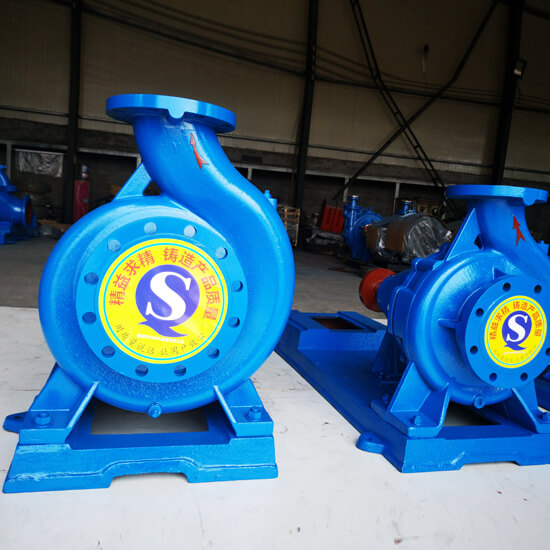Centrifugal Pump Suction Pipeline Design
During the working process of the centrifugal pump, users often ask the following questions: Is there a requirement for the length of the straight pipe section in the arrangement of the inlet pipeline of the centrifugal pump? If so, on what basis? Does it include transition length?
According to different manuals/standards/specifications at home and abroad, now we will introduce the design requirements of the suction inlet piping of centrifugal pumps. It hopes that it will help avoid the pump set’s abnormal operation due to unreasonable suction port design in engineering applications.

Different Manuals/Standards/Specifications for Centrifugal Pump Suction Piping Design Requirements
In many engineering applications, the design and installation of piping systems are often not taken seriously but must follow some basic engineering practices. Unreasonable design and arrangement of inlet pipes may bring about the following series of problems:
- Insufficient pump output (flow reduction, head, and efficiency drop).
- There is a lot of noise during the operation.
- The vibration of the pump set exceeds the standard.
- Premature failure of bearings and mechanical seals.
- Premature wear and failure of other pump parts, such as wear rings.
- Cavitation damage to the impeller and pump casing.
- Leakage occurs at the interface flange.
Except that there is no uniform standard for the length of the straight pipe section, the requirements of different manuals/standards/specifications for the design of the inlet piping of centrifugal pumps are similar.
Petrochemical Plant Process Pipeline Installation Design Manual
- The pipeline (arrangement) should try to “step up” or “step down” without airbags and liquid bags and try to avoid dead zones.
- For pipelines containing solid particles, to avoid particle sedimentation from blocking the channel, it can connect the branch pipe of the pump with a large slope or a 45° angle.
- For the pump with side suction, when the liquid enters the pump nozzle, if there is a bias flow or eddy current, it will destroy the flow balance of the fluid in the impeller and the head and shaft power of the pump will be affected. With different design requirements, air resistance will result in vibration and noise, which will deteriorate the performance and shorten the pump’s life. In order to prevent this phenomenon, there should be a straight pipe section with a length greater than three times the pipe diameter between the inlet of the centrifugal pump with side suction and the first pipe fitting and then can connect the elbow.
- For double-suction centrifugal pumps, the suction pipeline should have a straight section to make the thrusts on both sides of the pump shaft equal and the impellers balanced. When the suction pipe is parallel to the pump shaft and connected to the pump on the same plane, there should be a straight pipe section of more than 7DN in front of the suction port flange of the pump. It prevents the medium from drifting due to the elbow, reducing the pump efficiency and damaging the impeller. When the suction pipe is at the right angle to the pump shaft and connected to the pump suction nozzle, the straight pipe section can include elbows (radius), the large and small ends (transition section), and the shut-off valve can also be regarded as straight pipes. If it is challenging to install the straight pipe section, install a rectifier pipe or a baffle near the pump nozzle to prevent bias flow and eddy current.
Sinopec Engineering Construction Corporation "Pump Piping Design Regulations SEPD 0111-2001"
- The suction pipe of the pump should be as short as possible and with fewer turns to satisfy the thermal stress (generally no more than 3 meters for engineering plastic centrifugal pumps, no more than two elbows, appropriately increase the metal pump). Under no circumstances shall “air pockets” be allowed in the inlet piping.
- The suction port of the double suction pump should be provided with a straight pipe section not less than three times the length of the pipe diameter. There should be a straight pipe section with a diameter of more than seven times for large pumps so that the liquid can enter the pump smoothly and avoid bias flow and rotating flow, causing pump vibration and noise.
- When the piping of the double suction pump is upper section, it is not necessary to consider the required straight pipe section on the suction port. it can directly connect vertical pipes to the suction nozzles through elbows and reducers.
National Standard GB50275-2010 "Code for Construction and Acceptance of Installation Engineering of Compressors, Fans, and Pumps"
- The diameter of the suction line should not be smaller than the diameter of the pump inlet.
- When using a reducer, the length of the reducer should not be less than 5 to 7 times the diameter difference.
- There must be no air mass in the installation of the suction pipe.
- The length of the straight pipe section before the pump inlet should not be less than three times the diameter of the inlet.
API RP 686 Standard "Practice Guide for Mechanical Equipment Installation and Installation Design"
The pump inlet pipe should have a straight pipe section between the inlet flange and the first elbow, tee, valve, pressure reducer, permanent filter, or other equipment that can affect the stability of the inlet medium flow. The typical straight pipe section length five times the pipe diameter.
French Company Piping Design Requirements
For double-suction pumps in the form of “side entry and side exit,” when installing the first elbow on the suction side horizontally, there should be a straight pipe section of at least five times the pipe diameter between the suction end of the pump and the first elbow. Conversely, when installing the first elbow on the suction side vertically, it can ignore the straight pipe section on the suction side of the pump. Kawasaki’s pipeline design regulations require that the length of the straight pipe section before the inlet of the single-suction pump should not be less than three times the diameter of the inlet. The size of the straight pipe section before the inlet of the double-suction pump should not be less than five times the diameter of the inlet. The straight pipe section refers to the distance between the big and small head (transition section), and this straight pipe section includes the temporary filter.
For double-suction centrifugal pumps, the SULZER pump requires at least seven straight pipe sections with a pipe diameter of more than 7.
